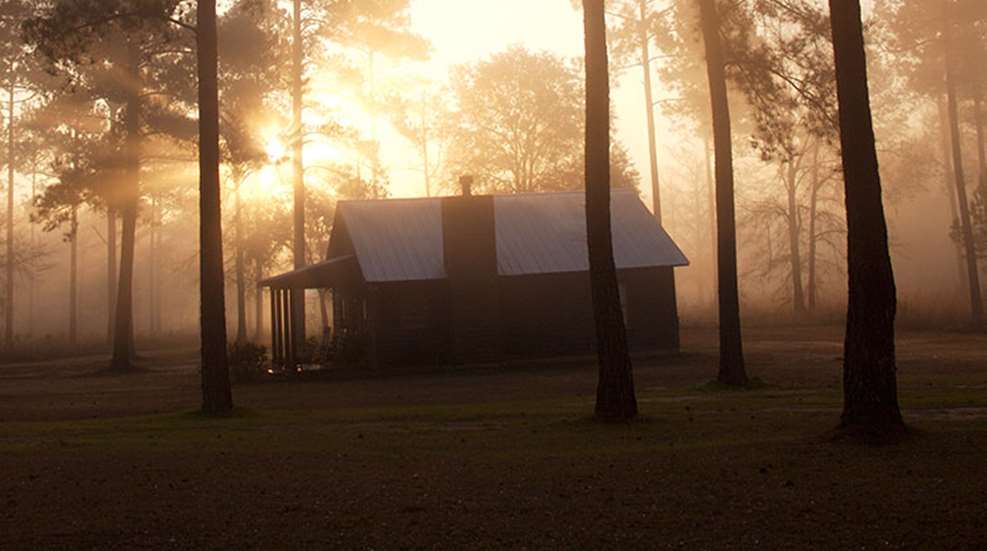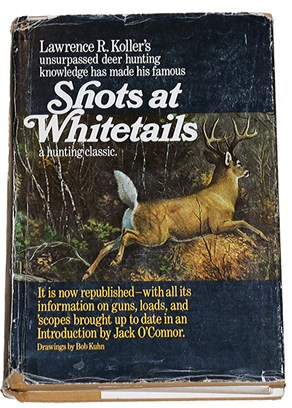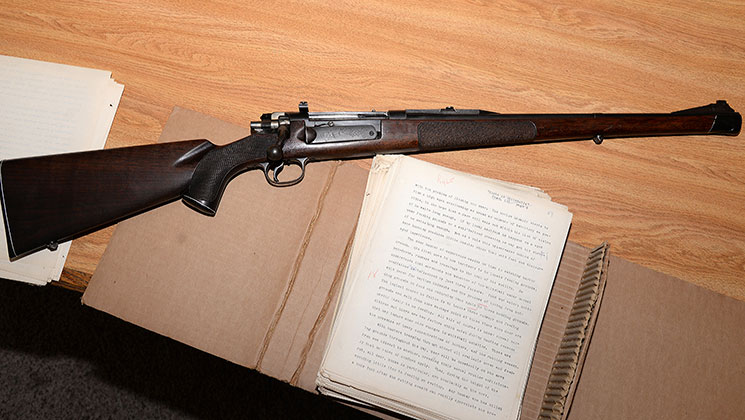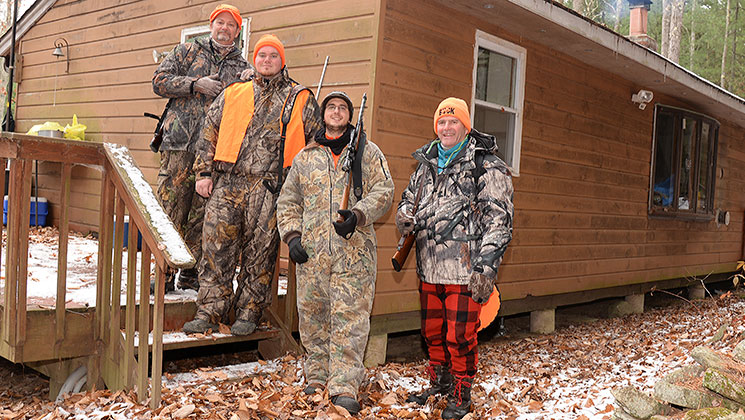
If you stand left of the giant hemlock at dawn and stare through its dead branches to the far shore of the Neversink River, you can almost see the homemade footbridge swinging in silver mist above the roiling, rock-strewn waters. And if you peer beyond those swaying slats to the opposite hillside, you swear that’s Lawrence R. Koller puffing a cigarette and cradling his .30-40 Krag as he awaits opening day’s shooting light near Monticello in New York’s Catskill Mountains.
Maybe you imagine such things because you’ve read Shots at Whitetails too many times since your youth. Or maybe Larry Koller, its author, seared those images into your teenage imagination the first time you opened his classic book, making you fall in love with deer camps, deer hunting and the Catskills, even before you first hunted deer.
And so now, as you hunt deer within a short walk of where the Eden Falls Hunting and Fishing Club’s shacks and sheds once stood, you think of your aging copy of Shots at Whitetails, and in your mind gently turn its yellowing pages to Chapter 5, where Koller waits to still-hunt the hills above the nearby Shinglekill River in southwestern Sullivan County. Koller was there with two friends, “purely on my say-so that it was good deer country.”
 He wrote: “The first pink rays of sunrise bathing the top of the ridge above stirred me from my reverie. It was time now to get up on that ridge and look for my buck. … Slowly, reluctantly, fearful of making any sound that might break the spell of silence, I began the climb.”
He wrote: “The first pink rays of sunrise bathing the top of the ridge above stirred me from my reverie. It was time now to get up on that ridge and look for my buck. … Slowly, reluctantly, fearful of making any sound that might break the spell of silence, I began the climb.”
Much has changed in the 67 years since Koller recalled that hunt near Cahoonzie. The rugged hills and valleys he still-hunted remain, but their forests keep maturing and no longer support as many deer as in Koller’s era. The camp’s original buildings are gone. The members tore them down about 20 years ago when New York state bought much of the land where Koller, his friends and family members hunted, fished, worked and played. The “new” camp is uphill about a quarter-mile away on 6 acres of club property, which includes a shooting range and a utility shed built from the old camp’s salvaged wood.
The camp’s footbridge across the Neversink is also long gone, save in crinkled black-and-white photos in camp scrapbooks. The bridge’s only physical remains are weathered warning signs nailed into the old hemlock by New York State Department of Environmental Conservation workers months before its demolition in early 1990. But that’s more than what marks the camp’s original setting. If you don’t have a club member showing you around, you’ll likely overlook the site where Koller returned each night after hunting all day for “his buck.” The forest’s relentless reclamation efforts remain indifferent to men and legends.
The Still-Hunter
Likewise, many aspects of what Koller loved best about deer hunting are gone, too. Koller lived only 19 years after Shots at Whitetails was first published, dying in August 1967 at age 54. His preferred hunting method, still-hunting, was well-suited for the roughly 4,000 acres that club members once roamed. But now still-hunting—which Koller defined as “moving quietly through the woods and swamps [while] looking, stopping and watching with patience and care”—has been largely squeezed from this forest. That squeeze wasn’t done by trees and underbrush, but rather by an evolving preference for tree-stand hunting and real-estate sales that broke properties into increasingly small parcels whose owners forbid all trespass.
Koller would probably be displeased to learn most Eden Falls members today hunker stubbornly on ladder stands. Such safe, well-made portable stands weren’t available in Koller’s era, of course, which might explain why he ridiculed hunting from a tree: “[It] has all the earmarks of prime foolhardiness. For the bit of extended vision it grants, a hunter pays the price of limited movement, exposure to wind, tree swaying to deflect his aim, and more importantly, the hazard of falling out when he shoots.”
Ernie Thiesing of Stony Point, N.Y., hunted often with Koller at the Eden Falls camp, and recalled Koller’s preference to hunt deer alone on foot. “He’d say you have to go find your deer, go find your buck,” said Thiesing in November 2014, three months before dying at age 90. “He didn’t like waiting for deer to come to him. He was always out bird hunting to scout for deer sign so he knew where to hunt and organize drives. He knew the property, and he was always one of the drivers. He didn’t like sitting.”
Even though Koller respected the “Spartan courage” needed to stick to a stand in cold weather, he thought sitting limited “the scope of a sportsman’s knowledge” and kept hunters “out of tune with the normal theme of deer hunting thrills and pleasure.” Further, “Deer hunting for them becomes a battle of the elements, often antagonistic during the open season in any of the Northern deer hunting zones.”
Deer-Drive General
Koller, however, stressed cooperation and perseverance when coordinating the camp’s frequent deer drives, which usually featured about 10 hunters. He assigned standers specific places to wait, designated by number-stamped metal tags nailed into trees. He further believed “intelligent deer driving will kill more deer than any other method,” which meant careful planning and dutiful cooperation by standers and drivers alike.
He wrote: “The glory of killing a driven buck will always be tempered in the hunter’s mind by the fact that someone else had a large part in helping him get a shot. Nevertheless, it’s fun. In no other phase of deer hunting do we encounter the same wealth of odd situations and humorous anecdotes than we do from the deer-driving fraternity. And success … requires a wealth of woodcraft, which helps us lay out the drive.”
Unfortunately, the same forces that eventually crippled still-hunting also discourage drive-hunting today. Koller and his comrades in the mid-1900s could choose from several time-tested drives without fear of sending deer to nearby hunters on public lands, or sparking conflicts with surrounding landowners. In fact, when Koller describes encounters with unknown hunters in Shots at Whitetails, it’s usually a comical tale about poor shooting, misidentified buck snorts and other shortcomings of unfortunate greenhorns. Further, as with most deer camps today, the Eden Falls Hunting and Fishing Club seldom has 10 hunters show up for deer season, and never more than a handful on any given day.
Despite all the social, tactical and landowner changes in Catskills deer hunting of recent decades, Koller’s love for the woods and camp camaraderie would still mesh with those hunting the lands he once roamed. Christopher Thiesing, Ernie’s son, was a grade-schooler when he took shooting lessons from Koller. Thiesing said Koller was a “field general” who would hold a camp together in this era where hunters zip in and out for half-day to three-day hunts, and few settle in for weeklong efforts.
Camp Camaraderie
“What mattered most to Larry was helping people,” Chris Thiesing said. “When Larry was in camp, he always had a circle of people around him, listening to his stories and laughing. Boy could he tell a story. You could taste, smell and see what he was describing. He was an expert in everything about deer hunting, and he poured all that knowledge into Shots at Whitetails. He was a skilled hunter, cook, handyman, gunsmith, taxidermist, writer, editor, author and radio personality; and he never attended college. He taught me gun safety and how to shoot. When my dad started bringing me to camp when I was about 5, he’d say, ‘You listen to Larry and do what he says.’ They don’t make people like Larry Koller anymore. I just wish he hadn’t died so young. He had so much to offer.”
Koller’s influence is obvious in the club’s constitution and bylaws, which remain posted in the dining area. In Article 1, Section 2, under “Objects of this club,” Item C reads, “To provide for its membership a sylvan retreat wherein they may relax and enjoy the unspoiled beauties of nature.”
Koller believed Item C’s objective required camp members to be good companions: “Cooperative qualities, good common sense, and a willingness to equally share labors and discomforts will shine in the golden light of memory when the next autumn finds Jack Frost painting his landscapes,” he wrote.
When reading such passages from Shots at Whitetails, Thiesing can’t hide his disappointment in how Koller’s legacy has faded in this rugged region, which is only a two-hour drive from Manhattan. He doesn’t blame it on encroachment or development. After all, the Catskills’ forests—though mature—remain vast, intimidating and often impenetrable, even to cell-phone signals. No, he attributes such losses to societal changes, the passing of time, and the deaths of those who knew Koller and hunted with him.
“Most people today don’t sit down and read good books, no matter who wrote them,” Thiesing said. “Heck, even my own sons haven’t read Koller’s books, but you can’t force the Bible on people, either. Technology changed everyone’s pace, and most people today get stressed if they can’t watch TV or connect to the Internet. Most guys today seem to measure the hunt by what they haul out.
“But that’s exactly why some of us still like hunting where Larry Koller hunted,” Thiesing continued. “I’m still inspired by the lore that Larry Koller, my dad, Bill Ziegler and their friends brought to camp. When they came here, it was like a metamorphosis for them. Even as a kid, it fascinated me. Dad would get in the car with me on Friday as a stressed salesman. By the time we returned Sunday night he was my dad again. It wasn’t all about Larry Koller, but he was a big part of that equation. I wanted to be part of that, and I still do.”
Koller’s Lore and Legend
For lack of a better term, Thiesing has become the resident historian and flame-tender for Koller and the Eden Falls Hunting and Fishing Club. Koller died relatively young, and so did his three children, none of whom were active as adults in the club their father helped to found.
A few years ago, Thiesing and a friend pooled their resources to buy a couple of large Rubbermaid tubs stuffed with Koller’s old photos, manuscripts and mementos. The collection included the original typewritten Shots at Whitetails manuscript, complete with an editor’s red-lined notes and edits.
Thiesing also owns Koller’s beloved .30-40 Krag, a military rifle Koller customized for deer hunting. Thiesing received the rifle as a gift from Koller’s youngest son, Paul, during Paul’s final trip to the club and Neversink River in March 2000. Paul Koller warned Thiesing that the Krag is only a keepsake, however, because it can no longer be safely fired.

Therefore, when Thiesing, his sons Brett and Jason, and other camp members welcomed me to hunt with them in November 2014, we stuck with modern scoped rifles, and only imagined the charms of hunting deer with the old peep-sighted Krag. As Koller noted in Shots at Whitetails, although “dozens of different riflescopes” were available when he wrote his classic book, “only a small proportion … are suited to white-tailed deer hunting.”
No matter which sights he used, however, Koller preferred one target above all others when aiming at whitetails: their white throat patch. “It is almost impossible for me to overemphasize the importance of the throat patch as a target,” Koller wrote. “It stands out clearly against the deer’s gray-brown body, and is large enough to make a good target if a hunter can hold his shots within a 6-inch circle at 50 yards.”
Timeless Thrill
I kept Koller’s advice in mind when watching a young buck feed along a draw near noon on Nov. 15, 2014, opening day of New York’s firearm season. After spending most of the morning below the woodland trail the club calls “Park Avenue,” I had moved far uphill for a better view of the vast gorge cut and shaped by the Neversink. About 11 a.m., the little 6-pointer slowly worked through the oaks, hemlocks and white pines, searching for acorns.
The buck, however, never offered a clear shot, let alone a good look at its throat patch, and so it likely still roams the forests around the Eden Falls camp. With luck, it will grow a bit older and someday induce a serious case of buck fever for a club member. After all, as Koller notes, the woods hold no greater excitement.
“There is no way to counteract the thrill attendant on first sighting a white-tailed buck, nor should there be,” Koller wrote. “Such a thrill is the primary reason for hunting deer, and without it, a man might
better sit home by the fire and recount the experiences of youth, when heart-stopping thrills were still a part of his existence. Any sportsman who can kill his deer without the tingling spine, the quick clutch at his heart, the delicious trembling of nerve fibers when the game is finally down, has no place in the deer woods.”





































